
|




















|
|
|
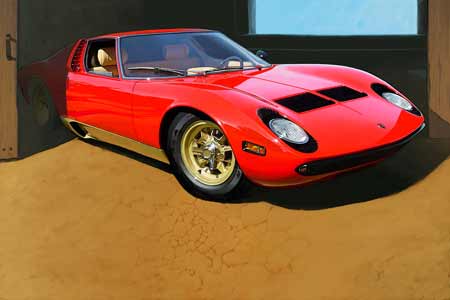
|
|
|
|
The "Bull in the Barn" by Roger Hector.
Click Here to purchase a print online from CarArt.us.
|
|
|
Miura Evolution Part II
Disucussions of a mid-engine GT car went on and the idea, rather than just fading away, took on a life if its own. They presented the concept to Lamborghini himself, and he went for it.
The Miura came into the world as a chassis, and was first presented at the 1965 Trino Salone dell'Automobile (Turin Automobile Show) in November. That the reception was immediate and overwelming is not hard to understand. At that time the mid-engine layout was new; it had taken hold as the chassis of choice in various European racing classes, and had recently been introduced to fans of the Indy 500. As a road car, while not unheard of, it was rare; as a high powered road car it was nothing short of revolutionary.
|
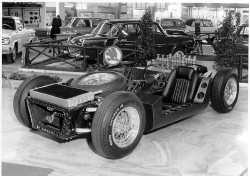
|
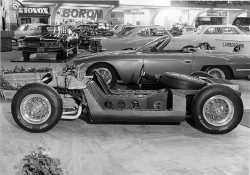
|
The Miura, without a body or even a name, as it was introduced to the world at the Turin Auto Show. The photos below clearly show an exhaust system whose details had yet to be worked out. Above left, the radiator is mounted in a last minute, let's put it here fashion. Also: this is the only time the factory put wire wheels on a Miura. Despite these humble beginnings, the exotic car world would never be the same.
Lamborghini press photos courtesy of Mark Jordan
|
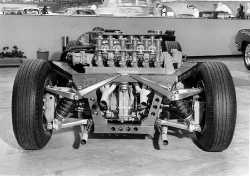
|
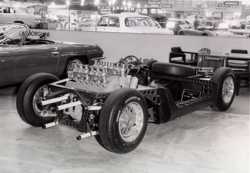
|
|
|
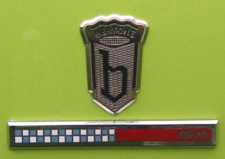 With a hit on their hands, Lamborghini now needed to clothe their new chassis. They chose Bertone, a firm with the ability to design and manufacture car bodies. Nuccio Bertone gave the plum assignment of designing the body to 25 year old Marcello Gandini.
With a hit on their hands, Lamborghini now needed to clothe their new chassis. They chose Bertone, a firm with the ability to design and manufacture car bodies. Nuccio Bertone gave the plum assignment of designing the body to 25 year old Marcello Gandini.
The body was designed while Giampaolo Dallara worked on chassis development, and both came together in early 1966. The complete package was presented to the world in March 1966 at the Geneva Auto show. Also revealed was the "Miura" model designation, named after a breed of Spanish fighting bulls. It was the hit of the show. There was also a promise of production and, despite skepticism, the orders came in, (10, according to one account) more in fact than were expected. Demand would never be a problem for the Miura; in fact supply was always limited by the factory's ability to produce.
Ferrucio Lamborghini was a showman with a flair for promotion and he saw the Miura as a way to generate publicity for the other cars he produced. The angle worked, as sales of all Lamborghini cars improved with the introduction and presence of the Miura. Initially he thought of the Miura as only a flagship car and planned for a production run of only about 30 examples.
This fact is important as it explains a lot about the Miura. Since it was seen only as a temporary and very limited production model, it was initially not well developed. The Miura constantly evolved during it's production life. Even though there are three distinct Miura models, the P400, the S and the SV, the changes were phased in gradually with some of them being applied to cars before or after their upgraded designation. Some of the changes made a good thing better, while others corrected mistakes that perhaps should not have been sold to the public. When production ended in 1972, the car was well sorted out, but it was a gradual process.
It is important to note that the other Lamborghini models of the time, notably the Espada, did not suffer the same fate and were solid, well sorted out cars that varied little in their production lifetime. It also should be pointed out that the development team suffered from a lack of resources and that the situation was common for small Italian car companies of the time.
|
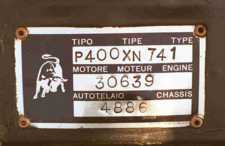
|
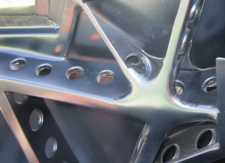
|
|
Left: Miura VIN plate. Right: The Miura looks good from the inside too. The detail work - all done by hand - is exceptional even in areas not normally seen. Superb craftsmanship is evident throughout. Note the use of lightening holes.
|
|
|
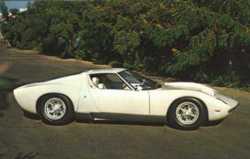
|
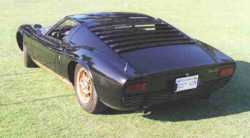
|
Left: 1967 Miura P400, s/n 3249, on a Briggs Cunningham museum postcard. The car was owned by the museum . . . just the thing to go pick up pastries for the crew. Right: 1967 Miura P400, s/n 0979, the first production Miura. The original color was orange red; it was painted black as part of a restoration in the late 1970s.
Miura Evolution, Part III
Note: Clicking on any photo will enable you to view a larger image.
(A new window will be opened in your browser)
|
|
|

Suggestions? Comments? Tell us!!!
|

|
|
|
|
